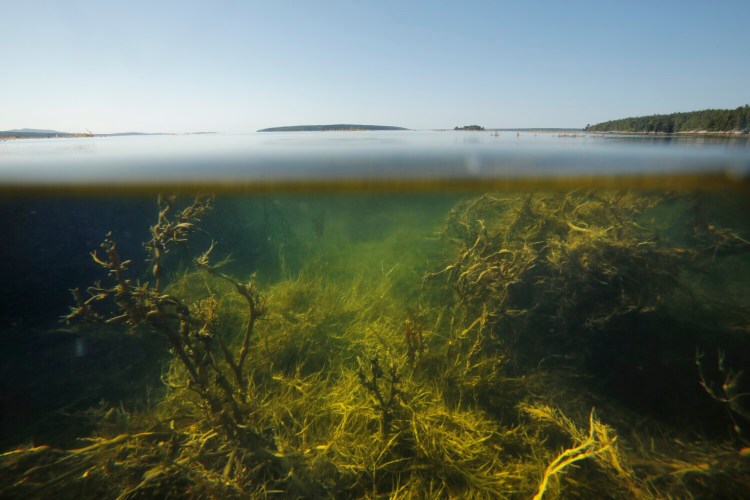The Gulf of Maine – which has been warming faster than 96 percent of the world’s ocean areas – experienced its warmest fall surface water temperatures on record last year in what scientists tracking it call a “distinct regime shift” for the ecosystem.
The Gulf of Maine Research Institute in Portland announced its findings Wednesday in its seasonal warming report, which showed average sea surface temperatures in the gulf hit 59.9 degrees, or more than 4 degrees above the long-term average.
Last fall’s figures exceeded even those in the infamous “Northwest Atlantic Ocean heat wave” of 2012, which triggered a two-year explosion in green crabs that devoured clams and eelgrass meadows and led to the starvation of puffin chicks. That warming cycle also triggered the early shedding of Maine lobsters, which fueled armed confrontations between Canadian lobstermen and truckers trying to carry the soft-shell boon to New Brunswick processing plants at the height of Canada’s own lobstering season.
The report showed that the most extreme warming is happening near the eastern entrance to the Gulf, where major cold and warm ocean currents bump against each other along the outer edge of Georges Bank. This makes the area the most susceptible to changes in large-scale ocean circulation patterns involving the warm-water Gulf Stream or the cold-water Labrador Current, which flows into the gulf through a deepwater passage off Nova Scotia and is spun around the gulf in a counter-clockwise gyre.

A close-up view of a bed of kelp seaweed, which once dominated the sea floor in the Gulf of Maine. Jennifer Dijkstra/UNH
“That’s the local manifestation of changes in the circulation patterns of the North Atlantic,” said GMRI research scientist Kathy Mills, who helped author the report. “We’re turning up the contribution of the gulf and turning down the Labrador Current, and that’s warming the gulf.”
That’s the primary reason that the Gulf of Maine – which extends from Cape Cod in Massachusetts to Cape Sable at the southern tip of Nova Scotia, and includes the Bay of Fundy, the offshore fishing banks, and the entire coast of Maine – has been warming faster than 96 percent of the world’s oceans.
GMRI’s report noted the gulf experienced marine heatwave conditions for almost the entirety of 2021, save for short reprieves in the early spring and midsummer. A marine heatwave is defined as five or more days in which sea surface temperatures for those calendar days were in the 90th percentile of those recorded in the thirty years ending in 2011.
The largest fall temperature anomaly occurred on Oct. 16, when surface temperatures reached 6.3 degrees above the long-term average.
Four of the top five warmest falls in the Gulf of Maine have occurred in the last seven years, GMRI reported. Since 2008, fall sea surface temperatures have warmed at a rate of about 1.1 degrees per decade.
The long-term warming of the Gulf of Maine and the world’s oceans generally is ultimately due to the release of greenhouse gases by industries, vehicles and other human activities that trap heat from the sun, increasing air and sea temperatures. “The oceans have been absorbing atmospheric heat and that’s been playing a big role in moderating the felt climate effects on land,” Mills said.
Last year also saw the second highest summer surface temperatures ever recorded, behind only those of 2012. Mills said having record temperatures in the fall appeared to generate fewer extreme ecological changes than having them in the spring, as was the case in 2012.
“That spring phase is really important to setting up the timing of various (biological) processes like spawning and lobster molting,” she said. “Whereas in fall, you see effects like species lingering longer, but because it’s the close of the season when things are winding down it carries through differently to biological systems and to people.”
Another factor, she said, was that people were starting to get used to the “new normal,” and so are less shocked to find warmer water species like blue crabs, squid or ocean sunfish in Maine waters. “Since 2012, some of the new patterns that began emerging in the ecosystem have now become more familiar,” she noted.
“Summer is now lasting longer on both sides,” she said. “There’s an onslaught of news of the magnitude and frequency of change being reported from around the world and we’re at the leading edge of having to adapt to that.”
Copy the Story LinkSend questions/comments to the editors.



Success. Please wait for the page to reload. If the page does not reload within 5 seconds, please refresh the page.
Enter your email and password to access comments.
Hi, to comment on stories you must . This profile is in addition to your subscription and website login.
Already have a commenting profile? .
Invalid username/password.
Please check your email to confirm and complete your registration.
Only subscribers are eligible to post comments. Please subscribe or login first for digital access. Here’s why.
Use the form below to reset your password. When you've submitted your account email, we will send an email with a reset code.